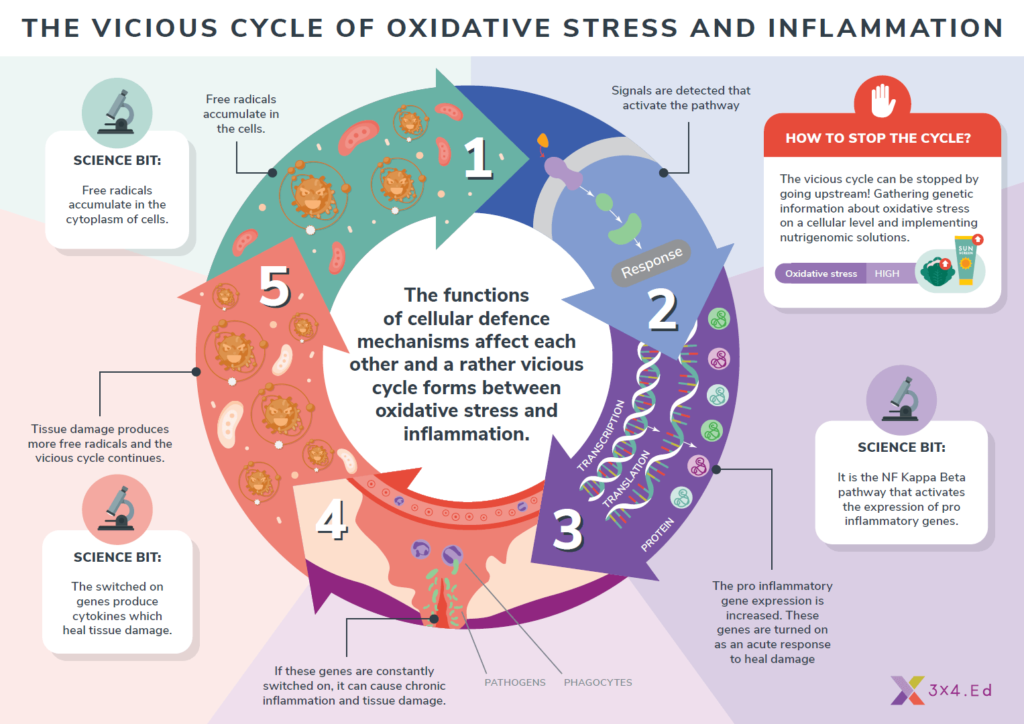What Is Oxidative Stress?
Imagine leaving a piece of metal outside, exposed to the elements. Over time, it rusts and weakens. Something similar happens in our bodies due to a process called oxidative stress. Just as metal rusts when it reacts with oxygen, our cells can be damaged when they’re exposed to unstable molecules known as free radicals. These free radicals cause wear and tear on our cells, and if left unchecked, they can lead to unhealthy aging and chronic disease.
Think of oxidative stress as a tug-of-war between free radicals, the troublemakers, and antioxidants, the body’s natural defenders. When free radicals overwhelm antioxidants, damage starts to build up, affecting our cells, tissues, and even our DNA. This damage can impact everything from our skin to our brain, speeding up aging and contributing to various chronic conditions.
Practical Tip: Start your defense by incorporating antioxidant-rich foods into your diet, like berries, spinach, and nuts. These foods can help neutralize free radicals before they cause too much damage.
The Science Behind Oxidative Stress
Oxidative stress happens when there’s an imbalance between harmful molecules (free radicals) and the antioxidants designed to fight them. Free radicals are unstable because they’re missing an electron, and they’ll try to “steal” electrons from other cells. When this happens, it causes damage, much like rust eats away at metal.
Reactive Oxygen Species (ROS) are a common type of free radical, produced naturally during normal processes like breathing and energy production. The problem arises when the body produces more free radicals than it can neutralize. This imbalance leads to oxidative stress, which gradually wears down your body’s systems.
Practical Tip: You can boost your body’s antioxidant defenses by adding more vitamin C (found in citrus fruits) and vitamin E (found in nuts and seeds) to your daily intake. These nutrients help your body maintain balance.
Sources of Oxidative Stress
Oxidative stress can come from a variety of sources, both inside and outside the body:
- Environmental factors: Pollution, UV radiation from the sun, and exposure to harmful chemicals increase free radical production.
- Lifestyle choices: Smoking, excessive alcohol consumption, and eating processed or sugary foods can elevate oxidative stress.
- Internal factors: Our bodies naturally produce free radicals as byproducts of normal processes, like when we digest food or exercise. Inflammation and infections can also contribute to this internal stress.
For example, studies show that smokers have significantly higher levels of oxidative stress compared to non-smokers. The free radicals from cigarette smoke overwhelm the body’s natural defenses, causing long-term damage to cells.
Practical Tip: Swap sugary snacks or processed foods for antioxidant-rich alternatives like leafy greens, dark chocolate, or blueberries. If you smoke, quitting is one of the best ways to reduce oxidative stress in your body.
The Role of Free Radicals in Oxidative Stress
Free radicals are naturally produced in the body, but factors like pollution, poor diet, and smoking ramp up their production. Think of free radicals as tiny thieves—they’re missing an electron, and to stabilize themselves, they steal from healthy cells. This “theft” causes a domino effect of damage, leading to what we call oxidative stress.
At the cellular level, this stress can break down the essential building blocks of life—your DNA, proteins, and lipids. Over time, this contributes to chronic diseases, aging, and even cancer.
Practical Tip: Include foods rich in selenium, such as Brazil nuts, fish, and eggs, in your diet. Selenium is a powerful antioxidant that helps repair damaged cells and protect DNA from oxidative damage.
Antioxidants: The Body’s Defense Mechanism
Antioxidants are like your body’s defense force, protecting your cells from free radicals. They work by giving free radicals the electrons they’re missing, neutralizing them before they can cause damage. There are two types of antioxidants:
- Endogenous antioxidants: These are produced naturally by the body, such as enzymes like superoxide dismutase and glutathione.
- Exogenous antioxidants: These come from food sources, like vitamins C and E, beta-carotene, and flavonoids.
A good balance of both types is essential for keeping oxidative stress under control.
Practical Tip: Boost your antioxidant intake by eating a variety of colorful fruits and vegetables. The pigments that give plants their vibrant colors are often rich in antioxidants!
Short-Term vs. Chronic Oxidative Stress
Not all oxidative stress is bad. In fact, acute oxidative stress (short-term) can actually be beneficial. It’s part of the body’s natural immune response and helps fight infections or repair injuries. However, when oxidative stress becomes chronic (long-term), it leads to ongoing cellular damage, contributing to diseases like heart disease, diabetes, and neurodegenerative conditions.
Chronic oxidative stress is like having a slow-burning fire inside your body—it wears down your systems over time.
Practical Tip: Regular exercise helps to reduce chronic oxidative stress. Just 30 minutes of moderate activity a day, like walking or cycling, can help your body manage oxidative stress better by enhancing your natural antioxidant defenses.
Effects of Oxidative Stress on the Body
Oxidative stress affects nearly every system in the body. It’s a key player in the development of various diseases, including:
- Cardiovascular disease: Oxidative stress can lead to the buildup of plaque in your arteries, increasing the risk of heart attack or stroke.
- Immune system dysfunction: It weakens the immune system, making you more prone to infections.
- Cancer: Long-term oxidative damage to DNA can lead to mutations and the development of cancer.
For example, research has shown that people with higher levels of oxidative stress are more likely to develop cardiovascular diseases.
Practical Tip: Add heart-healthy fats, like omega-3s found in fish and flaxseeds, to your diet. These fats help reduce inflammation and oxidative damage in the cardiovascular system.
How Oxidative Stress Affects the Brain
The brain is highly vulnerable to oxidative stress due to its high oxygen consumption and rich concentration of fatty tissues. Neurons (brain cells) are particularly sensitive to damage, and oxidative stress can impair their function. This contributes to the development of neurodegenerative diseases like Alzheimer’s and Parkinson’s.
Oxidative stress in the brain can also affect cognitive function, leading to memory problems and difficulty concentrating.
Practical Tip: To protect your brain, try consuming foods rich in omega-3 fatty acids, like salmon, walnuts, and chia seeds. Omega-3s help reduce inflammation and protect against neuronal damage.
Cognitive Impairments and Mood Disorders
Oxidative stress isn’t just about physical health—it’s linked to mental well-being, too. Research suggests that oxidative stress can trigger anxiety, depression, and memory loss. When oxidative damage affects neurotransmitters (the chemicals that communicate in the brain), mood disorders can develop or worsen.
Practical Tip: Incorporate stress-reducing activities, such as meditation, yoga, or deep breathing exercises, into your routine. Managing stress can help reduce the body’s oxidative load.
Aging and Oxidative Stress
One of the leading theories of aging is the free radical theory, which suggests that oxidative stress accelerates the aging process by damaging cells over time. This damage contributes to visible signs of aging, such as wrinkles, and internal signs like reduced organ function.
For example, oxidative stress speeds up the shortening of telomeres (protective caps on the ends of chromosomes), a key marker of cellular aging.
Practical Tip: Staying active and consuming antioxidant-rich foods can help slow the aging process. Green tea, rich in polyphenols, is a great addition to your diet for its anti-aging benefits.
Oxidative Stress and Inflammation
Oxidative stress and inflammation go hand-in-hand. When oxidative stress damages cells, the body responds with inflammation. However, chronic inflammation can lead to more oxidative stress, creating a vicious cycle. This loop is a driving force behind diseases like arthritis, asthma, and inflammatory bowel disease.

Practical Tip: Adding anti-inflammatory foods to your diet, like turmeric and ginger, can help break the cycle of inflammation and oxidative stress.
Measuring Oxidative Stress Levels
Measuring oxidative stress isn’t something you can easily see or feel, but it can be measured through specific biomarkers, such as malondialdehyde (MDA) or 8-hydroxydeoxyguanosine (8-OHdG). These tests assess the damage caused by free radicals in your body.
Practical Tip: If you’re concerned about oxidative stress, ask your doctor about specific tests that can measure oxidative damage or antioxidant levels.
Prevention and Management of Oxidative Stress
Preventing oxidative stress is about making lifestyle changes that reduce free radical exposure and increase antioxidant intake:
- Eat a balanced diet: Focus on antioxidant-rich foods like berries, leafy greens, and nuts.
- Exercise regularly: Physical activity enhances the body’s antioxidant defense system.
- Avoid harmful habits: Quit smoking, reduce alcohol consumption, and minimize exposure to pollutants.
Practical Tip: Make small, sustainable changes like adding a handful of nuts to your diet or swapping soda for green tea. These can have a big impact over time.

The Role of Meditation in Reducing Oxidative Stress
Meditation, a practice rooted in mindfulness and relaxation, has gained significant attention in recent years for its powerful effects on mental and physical health. One of its most profound benefits is its ability to lower oxidative stress. Studies show that regular meditation can reduce the body’s production of free radicals while boosting antioxidant levels, creating a more balanced internal environment. Essentially, meditation helps calm the “storm” of free radicals, allowing the body to better manage oxidative damage.
How Meditation Relieves Oxidative Stress
When we are stressed—whether physically or emotionally—our bodies produce an excess of free radicals. This stress can come from work, relationships, or even past emotional trauma. Meditation works by activating the parasympathetic nervous system, also known as the “rest and digest” state. In this state, the body relaxes, reducing the production of cortisol (a stress hormone) and inflammation, both of which are linked to oxidative stress.
A 2016 study published in the journal Psychoneuroendocrinology found that individuals who practiced meditation had lower levels of oxidative stress markers, such as malondialdehyde (MDA), compared to those who didn’t meditate. Additionally, the research showed an increase in glutathione, a powerful antioxidant produced by the body, in regular meditators.
Practical Meditation Techniques to Lower Oxidative Stress
If you’re new to meditation or unsure where to start, here are a few simple techniques to help you calm your mind and support your body’s fight against oxidative stress:
- Mindful Breathing: Focus on your breath for 5–10 minutes a day. Simply close your eyes, take slow, deep breaths, and pay attention to each inhale and exhale. This technique helps lower cortisol levels and promotes relaxation.
- Body Scan Meditation: Lie down in a quiet place and slowly bring your attention to each part of your body, starting from your toes up to your head. As you focus on each area, consciously release any tension you feel. This technique helps reduce muscle tension caused by stress and promotes emotional release.
- Loving-Kindness Meditation (Metta): This involves focusing on positive feelings and compassion for yourself and others. It’s been shown to reduce stress and anxiety, which are key contributors to oxidative damage. Repeat phrases like, “May I be happy, may I be healthy, may I be peaceful,” and extend these wishes to others in your life.

Practical Steps for Emotional Release to Improve Health
In addition to meditation, managing emotions is critical in preventing oxidative stress. Emotional stress, such as holding onto anger, resentment, or anxiety, can have long-term consequences on physical health. Emotional release techniques are tools that help clear stored stress and emotional baggage, improving overall health.
1. Journaling for Emotional Release
Writing down your thoughts and feelings helps process emotions that may otherwise lead to stress. By expressing these emotions on paper, you reduce mental strain, allowing the body to relax and reducing oxidative stress. Journaling for just 10–15 minutes a day can make a noticeable difference in your mental clarity and emotional well-being.
2. Emotional Freedom Technique (EFT) or Tapping
EFT combines the principles of acupuncture with psychological therapy. By tapping on specific meridian points while focusing on negative emotions, you can release trapped emotional energy. Studies show that EFT can reduce cortisol levels by 24%, according to a 2012 study published in The Journal of Nervous and Mental Disease. Lower cortisol levels are directly linked to reduced oxidative stress.

3. Deep Breathing and Visualization
When you feel overwhelmed, take a few moments to engage in deep diaphragmatic breathing. Close your eyes and visualize a calming place—such as a beach or forest. This technique lowers heart rate and blood pressure, reducing the oxidative load on your body. By practicing visualization for just 5 minutes a day, you can significantly lower your stress levels and improve your emotional resilience.
The Science Behind Emotional Release and Oxidative Stress
A 2019 study published in the journal Frontiers in Psychology found that individuals who regularly engaged in emotional release techniques—such as journaling, EFT, or mindful breathing—had lower levels of oxidative stress markers and better overall mental health. These emotional practices help to not only reduce stress but also improve immune function and resilience to chronic diseases.

Conclusion: How to Combat Oxidative Stress Naturally
In the battle against oxidative stress, the best defense is a balanced lifestyle. Eating antioxidant-rich foods, exercising regularly, and avoiding exposure to harmful substances can help keep free radicals in check. By making simple, everyday changes, you can protect your body and mind from the harmful effects of oxidative stress, promoting better health and longevity.
FAQs
What are the best foods to reduce oxidative stress?
Antioxidant-rich foods like berries, nuts, dark leafy greens, and green tea are excellent for fighting oxidative stress.
Can oxidative stress be reversed?
While you can’t completely reverse the damage, you can significantly reduce further harm by improving your diet, exercising, and avoiding toxins.
How does oxidative stress accelerate aging?
Oxidative stress damages cells, including DNA and proteins, which accelerates the aging process by affecting how cells function and regenerate.








